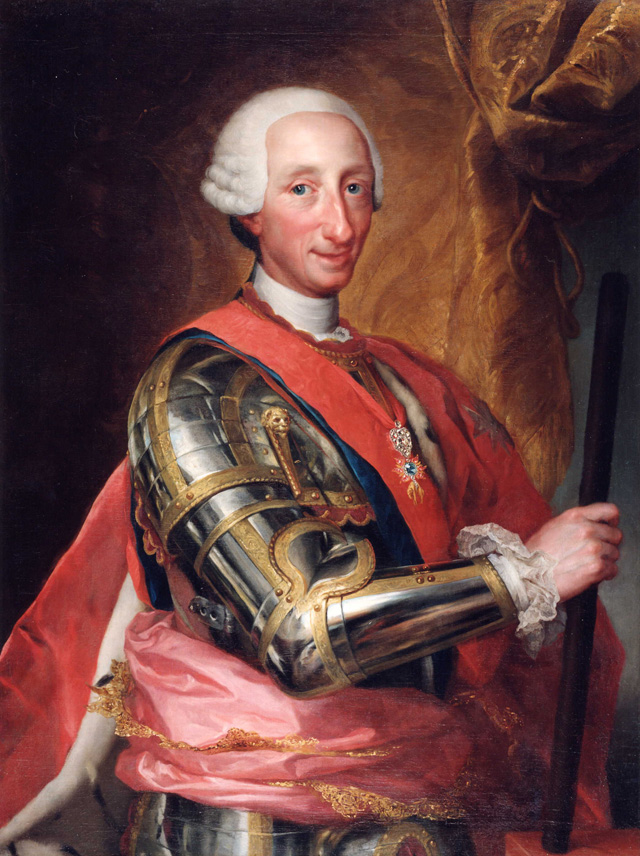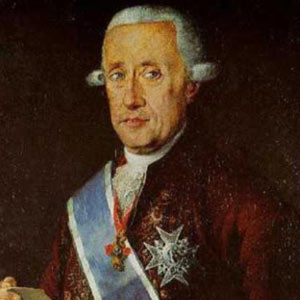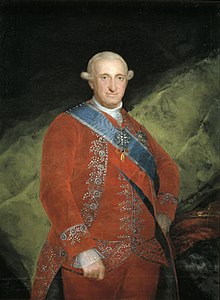Today in social sciences we have done several things. First Paqui has remembered Charles III. His father was Philip V and had two wife : Mary house of Savoy and Isabella of Farnese (his mother). Mary house of Savoy had two son : Louis I (1724)who reigned for 6 months in 1724 and Ferdinand (1746-1759) who had no children. The other wife was Isabella of France and she had a son: Charles III (1759-1788) king of naples for 20 years and influenced by Enlightenment. His main was Esquilache.

Source: http://images2.wikia.nocookie.net/__cb20091227035317/althistory/es/images/b/bd/Retrato_de_carlos_iii.jpg
Then, we have continued with the ESQUILACHE RIOTS: this occurred at the begginning of his reign, Charles III had some problems with the privileged. The privileged instigated the people's revolt using the new hygiene and public order ordinances as a pretext. The criminals covered themselves and It was difficult to identify them. The public order ordinances were anexcuse for the region and the privileged manipulated the people.
- The real causes: the privileged were angry with the ministre discontent of the privileged for the reforms Esquilache (Italian) was introducing.
- Excuse that started the riots: new hygiene and public order ordinances (including the ordinances about clothes).
- Consequences: Charles III dismissed Esquilache. Charles III expelled the Jesuits (accused of having participated in the riots) in 1767, accusing them of being responsible for the protsts but he didn't stop the reforms.

PUBLIC ORDER ORDINANCES
(cutting cloaks and brims)
Source: https://blogger.googleusercontent.com/img/b/R29vZ2xl/AVvXsEjHHFY-5WZ9-wd6SytS8u8QDyu0H74xUPkJKoMdgPURk8ZH6BU0ANZWY47Bgvc3gTZjzhnf0KERbOITvp91oEerfIiHrXGnAkya2mq0OZj0Sn1NSS0l_w1xPy86dhJ23a3DOtTxnAGAwOY/s320/esquilache.jpg
Paqui has drawn a hat in the blackboard and has explained that the brim is the visor of the hat.
Then, she has explained again the Enlightened Despotism and we have continued with Charles III's reforms:
ENLIGHTENED DESPOTISM: Some European monarchs adopted some ideas of the Enlightenment and introduced some reforms in their kingdoms, but, at the same time, they tried to preserve their absolute power. They made administrative, educational and economic reforms, but without asking their subjetcs for their opinion: they did "everything for the people, but without the people". They didn't touch the structure of power or the privileges of nobles and clergy. This is why the reforms they made were insufficient.
Representative of Enlightened Absolutism in Spain. Many of his minister were enlightened: Campomanes, Olavide, the counts of Aranda and Floridablanca.

Source: http://bartola71.wikispaces.com/file/view/conde-aranda.jpg/271439278/conde-aranda.jpg

Source: http://www.regmurcia.com/servlet/integra.servlets.Imagenes?METHOD=VERIMAGEN_26937&nombre=Conde_de_Floridablanca_-_Portada_res_720.jpg
Then we have continued with the enlightened reformism and Paqui has done a table in the blackboard about this. The table has divided into four parts:
REINFORCEMENT OF THE ROYAL POWER: in this part we have included:
- Expulsion of the Jesuits(1767).
ECONOMIC REFORM: in this part we have included:
- Colonization of new lands (in order to increase food production and improve agriculture).
- Limitation of the Mesta privileges (in order to increase food production and improve agriculture).
- Support to economic development throuth the Economic Societies of the Friends of the Country.
- Reports on the agrarian reform.
- Free trade with the Indies (all ports allowed).
- Liberalization of the price of wheat.
EDUCATIONAL REFORM: in this part we have included:
- Educational reforms: primary schools and reform of university studies.
SOCIAL: in this part we have included:
- Decree declaring honesty of all professions.
ADMINISTRATIVE REFORM: in this part we ha included:
- Administrative reforms in the Indies (2 more viceroyalties) Nueva Granada and Rio de la Plata.
All these were enlightened reform and all these reforms were limited and didin't questions the structure of the Ancien Régime.
EXPULSION OF THE JESUITS
Later, Paqui said that Charles III created during his reign:

San Carlos de Valle, in Campo de Montiel.

La Carlota, Jaen.
And we have remember mesta. This definition we have studied in 2nd of ESO. Mesta was an organization that protect the rights of the stockbreeders in Castile.
Later, we have finished with the Charles IV (1788-1808). He was Charles III’s successor. When Charles III died, his son Charles IV became the new king. He was not gifted to rule and Charles III adviced him to keep the Counts of Aranda and Floridablanca as ministers. He chose a minister who was the lover of his wife.
His rule was conditioned by the French Revolution.

CHARLES IV
At the end of the class, some students have asked for the doubts of the exam. The exam will be the next Friday. It is the last examen of the term and in this exam include:
1-The Ancien Régime and changes in the 18th century.
2-Enlightenment and Enlightened Depotism.
3-Independence of the 13 colonies of North America and the creation of the USA.
4-The 18th century in Spain:
A)The War of Spanish Succession.
B)The first Bourbons.
1.Centralist Abolution: Philip V and Ferdinand Vi.
2.Enlightened Despotism: Charles III.
The bell has rung and the class has finished for today.
Some words of the vocabulary:
- cloak- capa.
- brim- ala del sombrero.
- streetlights- farolas.
- stand by- parón.
- social- decree declaring honesty of all profesion.
Paqui in the break has helped me with for the journal. THANK YOU PAQUI.
The class of today was very complete and interesting. Luck for the exam, classmates.
See you the next day!

5 comments:
Wow Siria, the journal its very complete, I think that you have included all. I haven't seen any mistake.
Congratulations Siria!
See you and good luck for the exam of friday.
Hello Siria,
I think you've done a very good work. I'll let some time to your classmates to check your mistakes and I'll come back tomorrow for my comments.
I hope you feel better now. Everything goes better if you calm down and organize a strategy in order not to be overwhelmed with work. You're a hard worker and you don't deserve suffering when you learn. Learning has to be a pleasure, not a torture. I hope you soon discover what you really like and enjoy with learning as much as I do. As I have told you this morning, I hate exams too, but I can't stop learning things!
Good luck for your exam marathon tomorrow!
I have read the journal and I have found some mistakes:
-king of NAPLES for 20 years and INFLUENCED by Enligthenment.
-The CRIMINALS covered THEMSELVES
-Yesterday we said that Charles III was a reform DESPOT:
-He chosed a minister who was the LOVER of his wife.
Paqui, I agree with you, Siria is a hard worker, but I understand her, because learning is a pleasure, but studying for exams is a torture, we hate them.
See you!
Hi classmates !
I think nobody loves exams. No person wants to make it, but we can't change for the moment the system hahaha.
I have found a little mistakes of spelling:
-Siria, you confused the names of Charles III's wifes. They are Mary Louise of Savoy and Isabella of Farnese. You have written Mary house and Isabella of France. This mistake are very silly and really funny.
-In the real causes you have written "the privileged were HUNGRY" instead of "the privileged were ANGRY".
-I think that after the picture of Charles IV you have written "the exam is the LAST Friday" instead of "the exam will be the NEXT Friday".
I'm not sure about my corrections...
Good luck for the exam !!!
Hello
María and Dani’s corrections are OK. These are my comments:
- Mary Louise of Savoy had two sons : Louis I (1724), who reigned for 6 months in 1724, and Ferdinand (1746-1759), who had no children.
- Enlightenment, His main minister was Esquilache.
- Some spelling mistakes: occurred, beginning
- When you explain the Esqilache Riots, don’t omit the verb: at the beginning… Charles III had some problems with the privileged. The privileged instigated
- It was difficult to identify them… You should add that the public order ordinances were an excuse for the riots and the privileged manipulated the people.
- Causes, minister, protests on the blackboard
- Charles III was a reformist despot: the representative of Enlightened Absolutism in Spain. Many of his ministers were enlightened: Campomanes, Olavide, the counts of Aranda and Floridablanca.
- Then we have continued with Charles III’s reforms .. Remember that we did this to analyze his reforms and confirm that he was an enlightened despt, because he only made reforms in some fields, and he didn’t change anything to reduce his power or the privileges.
- Colonization of new lands (in order to increase food production and improve agriculture) and the same with the limitation of the Mesta privileges
- San Carlos de Valle and La Carlota are examples of new villages created to colonize new land.
-Mesta was an organization that protected the rights of the stockbreeders in Castile.
Charles IV (1788-1808). He was Charles III’s successor…. He chose(d) a minister who was his wife.
-Some students have asked (for) the doubts of the exam.
- It is the last exam(en) of the term
-..has helped me with the journal.
That's all. You did a good work. See you!
Post a Comment